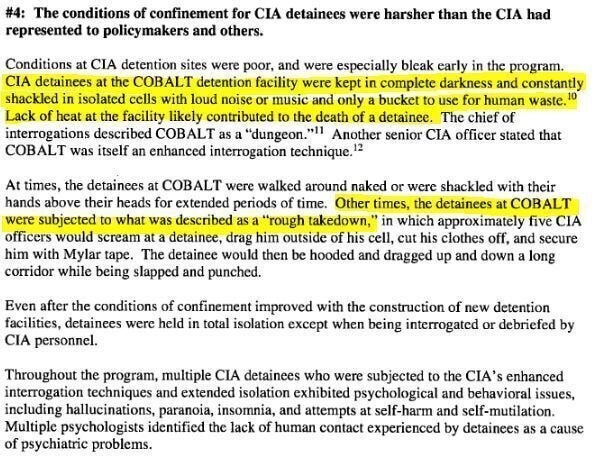Is the long-awaited report into CIA torture during the so-called "war on terror" an exercise on transparency or something rather less than that?
Seems to me it's clearly the latter. This is a 525-page "executive summary" of a 6,700-page report (sprinkled with 38,000 footnotes apparently), or about one thirteenth of the full report which, lest we forget, is still a top-secret classified document which seems set to stay that way. And the summary report itself is littered with blacked-out sections, with the Senate intelligence committee chair Dianne Feinstein saying that the redactions obliterate something like 7% of its content.
And of course this is not all. As The Intercept made clear ahead of this week's much-trumpeted publication, the Feinstein report has been the subject of months - possibly years - of struggle with the White House which was, we can surmise, under enormous pressure from the CIA and pro-Bush Republicans to thin out and water down the report. Moreover, the report is a narrow-focus one anyway, looking only at the CIA's conduct (not the US military or its contractors), and the report's authors rather amazingly didn't interview either the scores of actual victims of torture or the perpetrators or the perpetrators' superiors.
So no, this isn't really the revelatory report it may appear to be. The Senate's report pales in comparison even to the UK's recent Intelligence and Security Committee report into the murder of Lee Rigby - 200 pages into just this one case. Whatever the weaknesses of that committee as an investigatory body - and they're significant - the Rigby report's length is notable. (By the way, David Cameron's claim that war on terror torture has been "dealt with from a British perspective" is ... a very far cry from the truth). And of course a long process of leaks from the CIA report have drip-fed content into the media in a way that has - surely by design - reduced the impact of this week's report. The CIA's treatment having been "more brutal than was previously acknowledged" was already aired months ago, and numerous details about how detainees were tormented - a la Orwell's Winston Smith, with insects and other "Room 101"-type phobias - were known several years ago.
All this said, the Feinstein report still provides some depressing insight into the sheer horror of being subjected to the CIA's "enhanced interrogation techniques". This could include: having food or water forced into your body via your anus ("rectal feeding" or "rectal hydration"); being confined for days in a coffin-like "confinement box"; undergoing partial drowning until you were convulsing and vomiting (indeed waterboarding seems to have been used on a wider scale than previously admitted); being subjected to extended sleep deprivation (anything up to 180 hours per month) until you were hallucinating. Naturally, these would often be used in combination - along with beatings, strippings, threats (of rape, of death: to you and your children), stress positions, extremes of heat and cold, white noise auditory barrages ... and on and on. All being done to people who had been abducted and taken to places where there were no lawyers, no doctors (not ones on your side anyway), and no people to help you.
Here's just one example, concerning the so-called Salt Pit facility in Afghanistan:

One detainee, Gul Rahman, an Afghan national, died of hypothermia in 2002 after being shackled to a concrete wall with very little clothing in near-freezing conditions in the Salt Pit. His family only learnt of his death more than seven years later, when his name appeared in the media. Amazingly enough, the junior officer in charge of Salt Pit interrogations was at one stage recommended for a $2,500 bonus, and we also gather that no-one was ever even disciplined for Rahman's death, much less prosecuted.
And here, finally, is the nub of the issue. President Obama is willing to acknowledge that "These techniques did significant damage to America's standing in the world and made it harder to pursue our interests with allies and partners", and even - more flatly - that "we tortured some folks". But the buck seems to be getting stopped just there. The US Justice Department says it has no plans to initiate criminal investigations, despite what seems a wealth of evidence. And meanwhile supposed "liberal" figures like the former assistant secretary of state under Bill Clinton - James Rubin - are popping up in the media (eg Today programme, about 8.50am) to opine that the no-prosecutions decision is the right one, apparently seeing political convenience as superior to justice and remedy for victims.
Obama is right to say the kidnappings, secret detentions and torture in the war on terror damaged his country's standing in the world, but so too does failing to prosecute people for these manifest crimes. And so too does failing to close Guantánamo, itself a scene of rendition, torture and long-term detention without trial.
As if there wasn't already enough torture and suffering in the world - enough for Amnesty to launch a Stop Torture campaign to highlight its presence in over 140 countries - the USA's disastrous attempt first to semi-justify and then later to "turn the page" on all this has surely given the green light to torturers the world over. Yes the Senate Committee has made some attempt to grapple with this dark episode, but the report doesn't really lift the lid on the full depth and breadth of human rights abuse during the Bush/Cheney years. And Obama's administration seems content to keep it that way.
Meanwhile, when you read in the Senate report that certain CIA operatives brought with them the experience of using torture and other "counter-insurgency" techniques learnt in Latin America in the 1980s, you're left with the distinct impression that this is a far bigger problem than we're being led to believe. We don't need summary reports, we need the full Monty.
